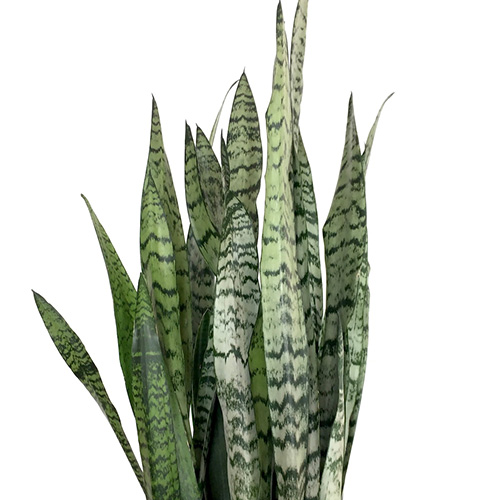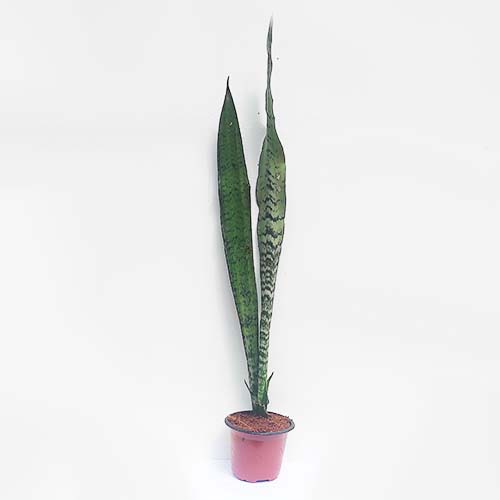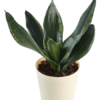SANSEVIERIA ZEYLANICA
This variety is often confused with the Sansevieria trifasciata variety, but it is a cousin to its African variety, commonly called as BOWSTRING HEMP. It is native to Sri Lanka and India. It grows longer, about 2-2.5 feet tall and 1 foot wide. The leaves of the plant are creamy- whitish in colour with horizontal dark green wavy stripes across the width of the leaves, margins can also be dark green coloured.
HOW TO CARE FOR YOUR SNAKE PLANT:
- This variety of the snake plant is very forgiving, grows robustly and adapts to all type of lighting condition from very low indirect light to full sunlight. But in darker rooms, the growth will be slower. (You know…how essential is light for the plants, right?)
- For the plant, some tilling of the soil won?t hurt once every month or so. Water the plant only when the upper layer of soil is dry up to 1 inch. Let the plant dry between subsequent watering. A watering schedule of once a week (or 10 days) is fine for plants kept indoors, while plants kept outdoors require a frequent watering due to evaporation.
- Fertilizing the plant once or twice a year is good. They generally show growth in spring and summer months, fertilizing at that time of the year will be great for your plant.
- Extreme cold temperatures up to 10 degrees or below are not good for the growth of plant. If planted in pots in the outdoors, bring the plant indoors.
- Snake plants like to be root bound, therefore, repotting depends on the fertilizer and sunlight you are providing, if the plant is growing faster you will need to repot it within a year or two. But snake plants kept indoors in medium to low light can be repotted 3-5 years.
- Prune the yellow, dull, brown, rotting leaves with the pruning shears.
- As already mentioned, it is a hardy plant and does not require much care. Plant it and let it do its work.
PROPAGATION OF SNAKE PLANT:
- Dear customers, always remember, a plant that has well developed root system is good for the propagation. These plants produce many baby plants (in rosettes) just beside the mother plant from its rhizome roots. You can just cut the baby plant and propagate in soil or in water.
- When propagating in water try to keep the leaves above water or else the leaves will rot. Change the water every few days. Propagating snake plants is trouble free.
- Propagation can also be done via leaf cuttings, cut 2-3 inches or longer leaf from the plant (the leaves can be cut horizontally) allow the leaf cutting to dry and put inside the soil up to 1 inch deep (plant the cutting matching the direction of the original growth of the main plant).
ORIGIN: Sri Lanka and India
COLOURS ON PLANT: Horizontal dark green wavy stripes on cream coloured leaves No Yellow margins
PLANT TYPE: Tropical plant, can be kept- Indoor and Outdoor(both)
SOIL: Well-draining soil mix
LIGHT REQUIREMENT: low, medium or high direct/ indirect light
WATERING: When upper soil feels dry (overwatering will cause death of plant)
FERTILIZERS: Once or Twice a year
PROPAGATION: By rhizomes (baby plants)
KNOW YOUR SNAKE PLANTS:
Sansevieria zeylanica also called as BOWSTRING HEMP is native to Sri Lanka and India. It grows longer, about 2-2.5 feet tall and 1 foot wide. Snake Plant (leaves appear somewhat like snakeskin), are very very very (undemanding) easy to care plant (easy ?100 times), just throw it, it will grow i.e., just an indestructible plant. These plants are here to make a bold statement in your rooms. There are some more than 70 varieties of snake plant.
According to NASA?s CLEAN AIR STUDY, (https://en.wikipedia.org/wiki/NASA_Clean_Air_Study), snake plants are known to remove benzene, formaldehyde, trichloroethylene, xylene and toluene, improving and purifying the indoor air quality.
TIP: IF YOU EVER WISH TO GIFT A PLANT TO YOUR NEAR AND DEAR ONES, DO CHOOSE SNAKE PLANTS (don?t go on the name!!), YOU CAN NEVER GO WRONG WITH THIS PLANT.










Reviews
There are no reviews yet.